UP Board Solutions For Class 9 Science Chapter 8 Force And Laws Of Motion Very Short Answer Type Questions
Question 1. Give two examples of the effects of force.
Answer:
Examples of the effects of force
A toy car starts moving when pushed.
The shape of the dough ball changes when rolled.
Question 2. Apart from changing the magnitude of velocity of an object or changing the direction of motion of an object, what other changes can force bring on an object?
Answer:
Force can change the state of rest to the state of motion and vice-versa. It can also change the shape and position of the body.
Question 3. Why friction does not pull a ball backward if no force is pushing or pulling it?
Answer:
Friction comes into action only in the presence of an applied force.
Question 4. Using a horizontal force of 200 N, we intend to move a wooden cabinet across a floor at a constant velocity. What is the frictional force that will be exerted on the cabinet?
Answer:
The frictional force is 200 N but in the opposite direction.
Question 5. What do you mean by resultant force?
Answer:
Resultant Force Definition
When two or more forces act on a body simultaneously then the single force which produces the same effect as produced by all the other forces acting together is known as the resultant force.
Question 6. While riding on the bicycle, if we stop peddling, why does the bicycle begin to slow down?
Answer:
The bicycle begins to slow down because of the force of friction acting in the opposite direction.
Question 7. While performing a practical, student A kept the wooden block on a polished wooden surface and measured the minimum force required to pull it as F1 while student B kept the wooden block on a rough surface, covered with sand, and measured the minimum force required to pull it as F2. They repeated the experiment five times. Which student applied more force to pull the block?
Answer:
Student B applied more force to pull the block because the friction force acting on the block placed on a rough surface was of large magnitude and opposite to the direction of force applied.
Read and Learn More Class 9 Science Solutions
Question 8. What did Galileo conclude on the basis of his experiments on the motion of objects?
Solution:
A body continues to move with the same velocity if no unbalanced force acts on it.
Question 9. Velocity-time graph of a moving particle of mass 1 kg
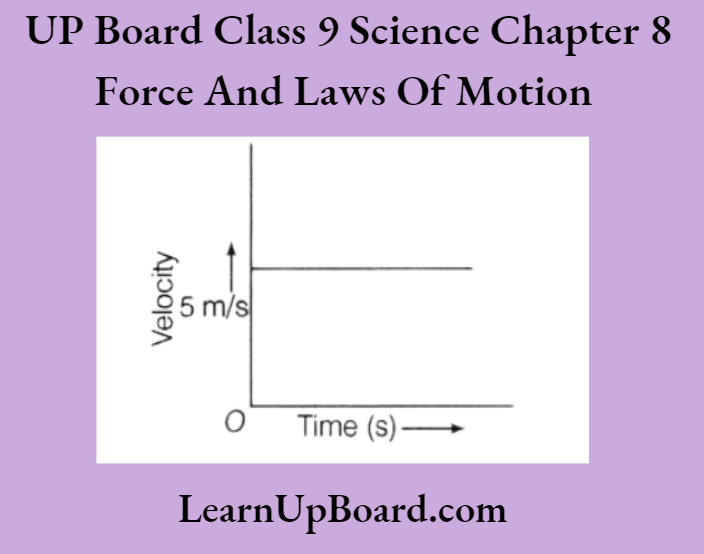
Is any force acting on the body? Justify your answer.
Answer:
The velocity of the body is uniform, thus acceleration is zero. Hence, no unbalanced force acts on the body.
Question 10. Why should we wear safety seat belts in a car?
Answer:
Due to our inertia, we may get hurt when the car suddenly starts or stops. Safety belts protect us by slowing down the motion in such situations.
Question 11. A water tanker filled up to — of its height is moving with a uniform speed. On sudden application of the brake, in which direction the water in the tanker would flow?
Answer:
On the sudden application of brake, the tanker will come in the state of rest but the water remains in the state of motion, so the water will move forward.
Question 12. Why do we tend to fall outwards when a car takes a steep turn?
Answer:
We tend to fall outwards when a car takes a steep turn due to inertia of direction.
Question 13. Name the agency which when applied to a body is directly proportional to the rate of change of momentum which it produces in the body.
Answer:
The force applied to a body is directly proportional to the rate of change of momentum.
Question 14. Two similar vehicles are moving with the same velocity on the roads such that one of them is loaded and the other is empty. Which of the vehicles will require a larger force to stop it? Give reasons.
Answer:
Both have the same velocity but one of them is loaded, so its momentum is greater than the other. Thus, for the loaded vehicle greater change of momentum, so larger force will be required to stop it.
Question 15. Athletes in pole jump events fall on a cushioned surface and not on the floor. Why?
Answer:
The change in momentum occurs over a long duration of time which reduces the force acting on the athlete and he does not hurt.
Question 16. A passenger in a moving train tosses a coin which falls behind him. From this incident, what can you predict about the motion of the train?
Answer:
If the coin falls behind the passenger that means the train is accelerated. When the coin is tossed, then it has the same velocity as that of the train but during the time it is in the air its velocity becomes less than that of the train (because the train is accelerated), so it falls behind the passenger.
Question 17. An athlete always runs for some distance before taking a jump. Why?
Answer:
When an athlete runs for some distance, then he increases his inertia of motion. At the jumping time, when he takes a jump, his increased inertia of motion carries him over a long distance or height.
Question 18. Name the physical quantity which corresponds to the rate of change of momentum.
Answer:
Force (according to Newton’s second law rate of change of momentum is known as force).
Question 19. A body accelerates when a balanced force acts on it. Is it true or false? Why?
Answer:
It is false because according to Newton’s second law, the momentum of a body changes only when an unbalanced force acts on it.
Question 20. A goalkeeper in a game of football pulls his hands backward after holding the ball shot at the goal. Explain.
Answer:
The goalkeeper pulls his hands backward after holding the ball to decrease the rate of change of momentum by increasing the time.
By doing this, less force is exerted on his hands. Since force is directly proportional to the rate of change of momentum.
Question 21. If a man jumps out from a boat to the bank of the river, the boat moves backward. Identify the action and reaction in this situation.
Answer:
The push of the man on the boat will be action while the boat exerts an equal force on the man, which will be a reaction.
Question 22. A runner presses the ground with his feet before he starts his run. Identify action and reaction in this situation.
Answer:
When a runner presses the ground, action is done by his feet and a reaction is produced by the ground, as a result runner moves forward.
Question 23. According to the third law of motion, do action and reaction forces act on the same body or different bodies?
Answer:
According to the third law of motion, action and reaction force always act on different bodies in opposite directions.
Question 24. Does Newton’s third law apply to a system where bodies do not touch each other?
Answer:
Yes. For example, in the case of attraction or repulsion between two magnets, etc. Newton’s third law is applicable.
Question 25. A balloon is inflated and released. Why does it fly forward as air escapes out of it?
Answer:
The reaction force of air coming out of the balloon pushes the balloon in the forward direction.
Question 26. Shyam throws a heavy stone out of his boat. As a result, the boat moves in the opposite direction, why?
Answer:
According to Newton’s third law of motion, action and reaction are always equal and opposite and act on two different bodies.
As the heavy stone is thrown in the forward direction, the boat moves backward.
Question 27. If F and F’ are balanced forces, then what will be the magnitude of \(F_2\)?
Answer:
As per the question, F and F’ are balanced forces.
So, F=\(F^{\prime}\)
15+F_2=25 N
⇒ \(F_2=10 \mathrm{~N}\)
UP Board Solutions For Class 9 Science Chapter 8 Force And Laws Of Motion Short Answer Type Questions
Question 1. A car is moving horizontally on a surface along a straight line at a constant speed. Is any force acting on it? If not, why is the fuel required to run it?
Answer:
Given
A car is moving horizontally on a surface along a straight line at a constant speed.
The car moves with constant velocity. So, no unbalanced force acts on it.
The fuel is used to move the car with a force that balances with the force of friction exerted by the surface due to the motion of the car.
Question 2. Make a pile of similar carom coins on a table. Then, remove the lower coin without touching the other coins. With your fingers, you may give a sharp horizontal hit at the bottom of the pile using a striker.
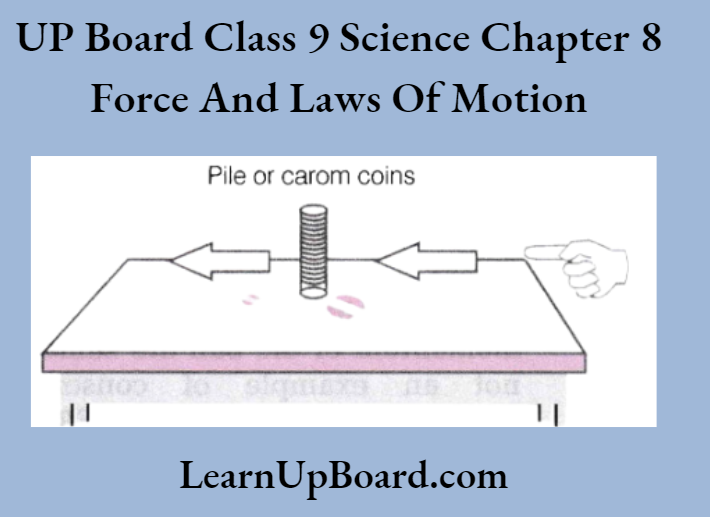
- What will happen, if the hit is strong enough?
- What will happen to the remaining coins once the lower coin is removed?
Answer:
- In case, the hit is strong enough, the bottom coin moves quickly, while the pile above remains at rest due to inertia.
- Once the lower coin is removed, the inertia of the remaining coins makes them fall vertically on the table.
Question 3. Why does the pillion rider fall forward when brakes are applied?
Answer:
During the ride, the pillion rider and driver are in a state of motion. But when the driver applies brakes, then the body of the pillion rider continues moving forward on account of the inertia of motion. Therefore, the pillion rider falls forward.
Question 4. There are three solids made up of aluminum, steel, and wood of the same shape and volume. Which of them would have the highest inertia?
Answer:
Given
There are three solids made up of aluminum, steel, and wood of the same shape and volume.
So Steel. As the mass is a measure of inertia, the ball having more mass than other balls will have the highest inertia. Since steel has the greatest density among these. So, it has the highest mass and inertia.
Question 5. A bullet fired against a glass window pane makes a hole in it and the glass pane is not cracked. But on the other hand, when a stone strikes the same glass pane, then it gets smashed. Why is it so?
Answer:
Given
A bullet fired against a glass window pane makes a hole in it and the glass pane is not cracked. But on the other hand, when a stone strikes the same glass pane, then it gets smashed.
When the bullet strikes the glass pane, then the part of the glass pane that comes in contact with the bullet immediately shares the large velocity of the bullet and makes a hole, while the remaining part of the glass remains at rest and is therefore not smashed due to inertia of rest.
But when a slow-moving stone strikes the same glass pane, then the various parts of the glass pane get enough time to share the velocity of the stone, and the glass is smashed.
Question 6. Why can a small mass such as a bullet kill a person when fired from a gun?
Answer:
It is so because even, if the mass of the bullet is small, it moves out of the gun with a very high velocity, due to which its momentum is high (p =mv). This high momentum of the bullet exerts a large force and kills a person.
Question 7. Why does a boat tend to leave the shore, when passengers are alighting from it?
Answer:
When the passengers are alight from the boat, the boat moves in a backward direction. This is an example of Newton’s third law. This difficulty is usually overcome by the boatman by binding the boat to some rigid support.
Question 8. How are action and reaction forces related to magnitude and direction?
Answer:
Action and reaction forces have the same magnitude but opposite directions.
Question 9. Describe our walking in terms of Newton’s third law of motion.
Answer:
When we walk on the ground or road, our foot pushes the ground backward (action) and the ground pushes our foot forward (reaction). Thus, the forward reaction force exerted by the ground on our foot makes us walk forward.
Question 10. Two identical bullets are fired one by one by a light rifle and another by a heavy rifle with the same force. Which rifle will hurt the shoulder more and why?
Answer:
Given
Two identical bullets are fired one by one by a light rifle and another by a heavy rifle with the same force
Both the bullets are identical and are fired with the same force. So, according to Newton’s third law of motion, the same force will be applied to both rifles. With the application of the same force, the light rifle will move more quickly in the forward direction, so it will hurt more to the shoulder.
Question 11. Which Newton’s law of motion is applied in the flight of a bird?
Answer:
For flight, a bird applies force on air in a backward direction by flapping its wings (action). Air exerts (a force) on the bird in the forward direction. Therefore Newton’s third law of motion is applied in the flight of a bird.
Question 12. (1) A heavy and a light object has the same momentum. Which of these is traveling faster?
(2) State the law of conservation of momentum. Give examples.
Answer:
- If two objects are moving with the same momentum, then the object having lightweight moves faster.
- According to the law of conservation of momentum, if an external force is not present, then the total momentum before the collision between the two bodies is equal to the total momentum after the collision.
Question 13. Two children stand on wheel carts facing each other. One student throws a heavy mass towards the other who catches it. What will be the direction of motion of both the children? Give a reason for your answer.
Answer:
Given
Two children stand on wheel carts facing each other. One student throws a heavy mass towards the other who catches it.
The child who throws the mass towards the other and the one who catches it, both move backwards.
Reason: The Thrower moves due to a backward reaction of mass pushed forward.
The catcher moves due to the forward reaction of mass pushed and held backward.
Question 14. Take a big rubber balloon and inflate it fully. Tie its neck using a thread. Also, using adhesive tape, fix a straw on the surface of this balloon. Pass a thread through the straw and hold one end of the thread in your hand or fix it on the wall.

Ask your friend to hold the other end of the thread or fix it on a wall at some distance.
This arrangement is shown in the figure. Now, remove the thread tied to the neck of the balloon. Let the air escape from the mouth of the balloon. Observe the direction in which the straw moves. Give reason.
Answer:
The straw moves in the opposite direction of air because when the air is released out of the balloon, it imparts momentum to the straw from Newton’s third law of motion.
Question 15. Two balls of the same size but of different materials, rubber, and iron are kept on the smooth floor of a moving train. The brakes are applied suddenly to stop the train. Will the balls start rolling? If, so in which direction? Will they move at the same speed? Give reasons for your answer.
Answer:
When the train is stopped suddenly, then it comes in the state of rest but the balls remain in the state of motion. So, due to the inertia of motion, the balls move in the forward direction.
As the balls are of the same size but of different materials that means their masses will be different. So, both the balls will move at different speeds.
Question 16. Suppose a ball of mass m is thrown vertically upward with an initial speed of v, its speed decreases continuously till it becomes zero. Thereafter, the ball begins to fall downward and attain the speed v again before striking the ground. It implies that the magnitude of the initial and final momentum of the ball are the same. Yet, it is not an example of conservation of momentum. Explain, why.
Answer:
The momentum of a system remains conserved if no external force acts on the system. In the given example, there is a gravitational force acting on the ball, so it is not an example of conservation of momentum.
Question 17. Two friends on roller skates are standing 5 m apart facing each other. One of them throws a ball of 2 kg towards the other, who catches it? How will this activity affect the position of the two? Explain your answer.
Answer:
Separation between them will increase. Initially, the momentum of both of them is zero as they are at rest. In order to conserve the momentum, the one who throws the ball would move backward.
The second will experience a net force after catching the ball and therefore will move backwards that is in the direction of the force.
Question 18. On what factors do the following physical quantities depend?
- Inertia
- Momentum
- Force
- Impulse
Answer:
- Inertia depends on the mass of a body.
- Momentum depends on the mass and velocity of the body.
- The force depends on the mass and acceleration of the body.
- Impulse depends on force and the short time in which force acts.
Question 19. Give a reason for the following questions:
- Road accidents occurring due to high speeds are much worse than accidents due to low speeds of vehicles.
- When a motorcar makes a sharp turn at a high speed passengers tend to get thrown to one side.
Answer:
- Road accidents occurring due to high speeds are much worse than accidents due to low speeds of vehicles. This is because the momentum of high-speed vehicles is more than that of the low speeds of vehicles.
- When a motorcar makes a sharp turn left or right at a high speed. The lower portion of their passengers turns suddenly along with the motorcar but the upper portion does not change its direction due to inertia.
- So, this portion of a passenger moves forward and the passenger tends to get thrown to one side or another side.
Question 20. Glasswares are wrapped in straw during their transportation. Justify giving a reason.
Answer:
Glasswares are wrapped in straw during their transportation.
During transportation, the glasswares may break, if they collide with each other in the event of jerks. When they are wrapped in straw, then the force of the jerk is transmitted to them through the pieces of straw for a longer period of time.
Thus, the change in momentum of the glasswares takes place over a longer period of time. Therefore, a very small force is experienced by them in the event of jerks and hence they do not break.
Question 21. What would happen if a fielder stops the fast-moving ball suddenly? Justify your answer.
Answer:
The high velocity of the ball decreases to zero in a short time. It means that in a short time, there is a large change in the momentum of the ball.
Therefore, to stop the fast-moving ball, the fielder will have to apply a large force and in the process, he may hurt his palm.
Question 22. Give a reason for the following:
- The water sprinkler used for grass lawns begins to rotate as soon as water is supplied.
- Water drops are removed from wet clothes by giving a tight jerk to the cloth.
Answer:
- When water is pushed out of the sprinkler with a force, it exerts reaction force on the sprinkler causing it to rotate.
- Water drops have the inertia of rest. They do not move with the cloth as it is jerked and comes out.
Question 23. What do you understand by momentum? A vehicle is moving with a velocity of 5 m/s. If the momentum of the vehicle is 5000 kg-m/s, then what is its mass?
Answer:
Momentum:
Momentum is the physical quantity which is the product of mass and velocity of an object. Momentum has both masses as well as the direction of motion. It is denoted by p. Its SI unit is kg-m/s.
Momentum, p = mv
Given, p – 5000 kg-m/s, v = 5 m/s, m -?
5000 = m x 5 => m = \(\frac{5000}{5}\) = 1000 kg
Question 24. A man Throws a ball weighing 500 g vertically upwards with a speed of 20 m/s.
- What will be its initial momentum?
- What would be its momentum at the highest point of its flight?
Answer:
Given, initial velocity, u = 20 m/s
Mass, m=500 \(\mathrm{~g}=\frac{1}{2} \mathrm{~kg}\)
Initial momentum, p_1=m u
⇒ \(p_1=\frac{1}{2} \times 20=10 \mathrm{~kg}-\mathrm{m} / \mathrm{s}\)
At the highest point, v=0
Final momentum,\(p_2\)=m v
∴ \(p_2=\frac{1}{2} \times 0=0\)
Question 25. A force of 30 N produces an acceleration of 2 m/s² in a body of mass m. Find the mass of the body. Also, find the acceleration, if force is doubled in magnitude along the same direction.
Answer:
Given
A force of 30 N produces an acceleration of 2 m/s² in a body of mass m.
Acceleration, a=2 \(\mathrm{~m} / \mathrm{s}^2\)
Mass of a body, m=\(\frac{F}{a}=\frac{30}{2}=15 \mathrm{~kg}\) [F=m a]
If F is doubled, a is also doubled as
F \(\propto\) a [since, m is constant]
So, a=4 \(\mathrm{~m} / \mathrm{s}^2\)
Thus, acceleration when force is doubled is 4 m/s.
Question 26. For how much time should a force of 200 N act on an object having a mass 5 kg, so as to increase its velocity from 50 m/s to 100 m/s? Given, force, F = 200 N Mass of an object, m = 5 kg Initial velocity, u – 50 m/s Final velocity, v = 100 m/s
Answer:
Given, force, F = 200 N
Mass of an object, m =5l.g
Initial velocity u -50 m/s
Final velociry u -100 m/s
From Newton’s second law of motion, we get
F=m a = \(m(\frac{v-u}{t}) [a=\frac{v-u}{t}]\)
200 =5\(\left(\frac{100-50}{t}\right)\)
t =5\(\left(\frac{100-50}{200}\right)\)
= 1.25 s
Thus, the time taken is 1.25 s.
Question 27. A cricket ball of mass 70 g moving with a velocity of 0.5 m/s is stopped by a player in 0.5 s. What is the force exerted by the player to stop it?
Answer:
Given, the mass of the cricket ball, m = 70 g = 0.07 kg
Initial velocity, u =0.5 m/s, final velocity, v = 0 Time, t =0.5 s
From Newton’s second law of motion, we get
F =m a=m\((\frac{v-u}{t}) [ a=\frac{v-u}{t}]\)
=0.07 \(\times\left(\frac{0-0.5}{0.5}\right)=-0.07 \mathrm{~N}\)
A negative sign shows that force is in the opposite direction to the motion of the ball. So, the magnitude of the force is 0.07 N.
Question 28. The velocity-time graph of a ball of mass 30 g moving along a straight line on a long table is given in the figure below.
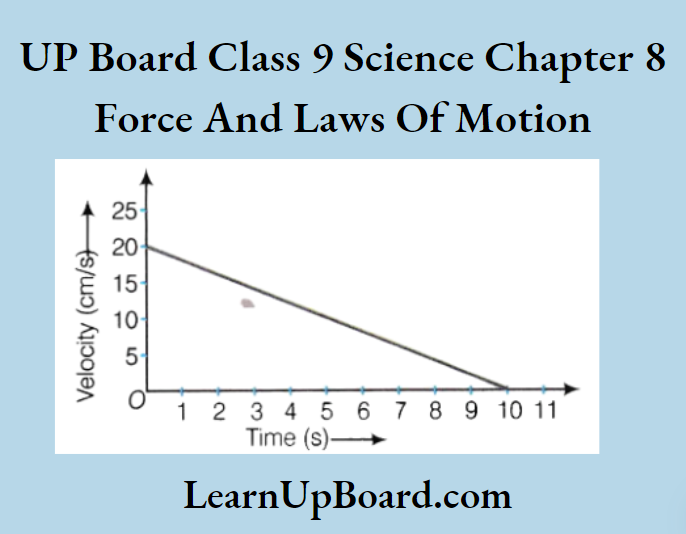
How much force does the table exert on the ball to bring it to rest?
Answer:
Given, the mass of the ball, m= 30 g = 0.03 kg
From the given graph, we note that u =20 cm/s = 0.20 m/s
v =0, t =10 -0 =10 s
As we know, the force exerted on the ball is given by
F = \(m\left(\frac{v-u}{t}\right)=0.03\left(\frac{0-0.20}{10}\right)\)
=-0.0006 N
Thus, the force exerted by the table on the ball is -0.0006 N.
Question 29. Two billiard balls each of mass 0.05 kg moving in opposite directions each with a speed of 6 m/s collide and rebound with the same speed. Find the impulse imported to each ball due to the other.
Answer:
Given
Two billiard balls each of mass 0.05 kg moving in opposite directions each with a speed of 6 m/s collide and rebound with the same speed.
The initial momentum of the ball
A = 0.05 x 6 = 03kg m/s and final momentum of the same ball
A = 0.05 x (-6) = -03 kg m/s /.
Impulse imported to ball A = Change in momentum = -03 -03 = -0.6kg m/s
An equal impulse is imported to ball B by ball A.
Question 30. A bullet of mass 20 g is fired from a pistol of mass 2 kg with a horizontal velocity of 150 m/s. Calculate the recoil velocity of the pistol.
Answer:
Given, mass of bullet, m = 20 g = 0.02 kg
Mass of pistol, M = 2 kg
Velocity of bullet, =150m/s
From the law of conservation of momentum, momentum of pistol = momentum of bullet MV = -mv
[Here, a negative sign shows that the direction of motion of the bullet and pistol are opposite to each other]
Velocity of pistol, V =\(-\frac{m v}{M}\)
= \(\frac{-0.02 \times 150}{2}\)
V =-1.5 m/s
Thus, the recoil velocity of the pistol is 1.5 m/s.
Velocity of pistol, V =-\(\frac{m v}{M}\)
= \(\frac{-0.02 \times 150}{2}\)
V =-1.5 m/s
Question 31. Find the acceleration and force acting on a body of mass 4 kg using the following v-t graph.
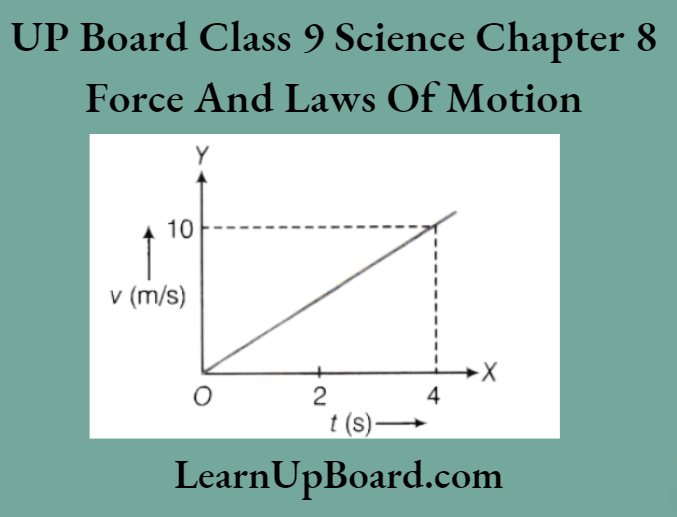
Answer:
Acceleration, a= Slope of the v-t graph
=\(\frac{Y \text {-intercept }}{X \text {-intercept }}=\frac{10 \mathrm{~m} / \mathrm{s}}{4 \mathrm{~s}}=2.5 \mathrm{~m} / \mathrm{s}^2\)
From Newton’s second law of motion, we get
F=m a=4 \(\times\) 2.5=10 \(\mathrm{~N}\)
Thus, acceleration and force on the body are 2.5 \(\mathrm{~m} / \mathrm{s}^2\) and 10 N, respectively.
Question 32. The force of ION applied to a mass mx produces an acceleration of 5 m/s² and when applied to mass produces an acceleration of 15 m/s² in the mass. How much acceleration will the same force produce, if the two masses are tied together?
Answer:
Given
The force of ION applied to a mass mx produces an acceleration of 5 m/s² and when applied to mass produces an acceleration of 15 m/s² in the mass.
We know that, F = ma
10 = \(m_1 \times 5 or m_1=\frac{10}{5}=2 \mathrm{~kg}\)
Also, \(m_2=\frac{10}{15}=\frac{2}{3} \mathrm{~kg}\)
Required acceleration produced when the masses are tied together (i.e. m = \(m_1+m_2\) ),
a = \(\frac{F}{m}=\frac{10}{m_1+m_2}=\frac{10}{2+\frac{2}{3}}\)
=\(\frac{30}{8}=3.75 \mathrm{~m} / \mathrm{s}^2\)
Question 33. A bullet of mass 4 g when fired with a velocity of 50 m/s can enter a wall up to a depth of 10 cm. How much will be the average resistance offered by the wall?
Answer:
Given
A bullet of mass 4 g when fired with a velocity of 50 m/s can enter a wall up to a depth of 10 cm.
The hindrance offered by the wall to the motion of a bullet is called the resistance offered by the wall. Given, Mass of the bullet, m = 4g = 4 x 10-3 kg
Initial velocity, u=50 \(\mathrm{~m} / \mathrm{s}\),
Depth, s=10 \(\mathrm{~cm}=\frac{1}{10} \mathrm{~m}\)
Final velocity, v=0, Force, F=?
Using the second equation of motion,
⇒ \(v^2 = u^2+2 a s\)
⇒ \(v^2-u^2 =2 a s \)
⇒ \(0-(50)^2 =2 a \times \frac{1}{10}\)
⇒ \(-2500 =\frac{a}{5} \Rightarrow a=-12500 \mathrm{~m} / \mathrm{s}^2\)
Force, \(F=m a=4 \times 10^{-3} \times(-12500)=-50 \mathrm{~N}\)
Thus, the average resistance offered is 50 N.
The negative sign indicates that the force is acting opposite to the motion.
Question 34. A heavy car A of mass 2000 kg traveling at 30 m/s has a head-on collision with a sport car B of mass 1000 kg. If both cars stop dead on colliding, then what was the velocity of car B?
Answer:
Given, mass of car A, \(m_1 =2000 \mathrm{~kg}\)
Mass of car B, \(m_2\) =1000 kg
Velocity of car A, \(v_1 =30 \mathrm{~m} / \mathrm{s}\)
and velocity of car B, \(v_2\)=?
Now, according to the law of conservation of momentum, \(m_1 v_1=m_2 v_2\)
2000 \(\times\)30 =1000 \(\times v_2\)
⇒ \(v_2 =2 \times 30\)
=60 \(\mathrm{~m} / \mathrm{s}\)
Question 35. The motion of a body of mass 5 kg is shown in the velocity-time graph.
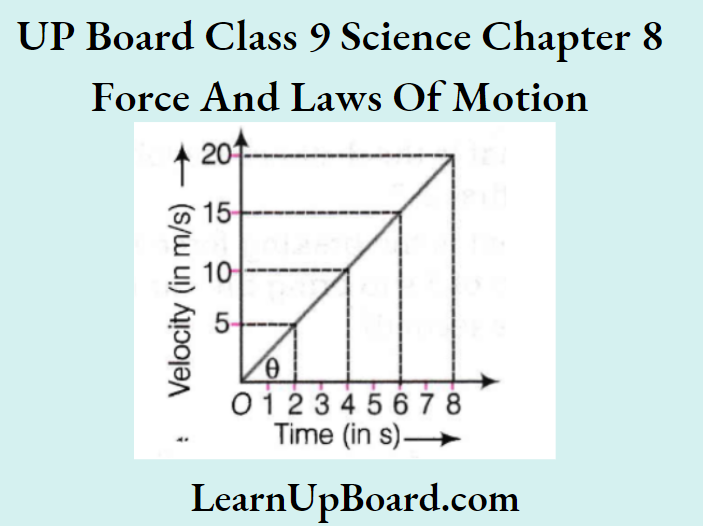
Find from the graph.
- Its acceleration.
- The force acting on the body.
- The change in momentum of a body in 2 seconds after the start.
Answer:
(1) Acceleration = Slope of the line of the velocity-time graph,
a =\(\frac{v_2-v_1}{t-t_1}=\frac{5-0}{2-0}=\frac{5}{2}=\frac{10}{4}\)
= \(\frac{15}{6}=2.5 \mathrm{~m} / \mathrm{s}^2\)
(2) The force acting on the body is given by
F=m a=5 \(\times\) 2.5=12.5 N
Change in momentum =m v-m u [ u=0 and v=5 m/s]
=5 \(\times\) 5-5 \(\times\) 0=25 kg- m/s
Question 36. The velocity-time graph of a ball moving on the surface of the floor is shown in the figure. Calculate the force acting on the ball, if the mass of the ball is 100 g.
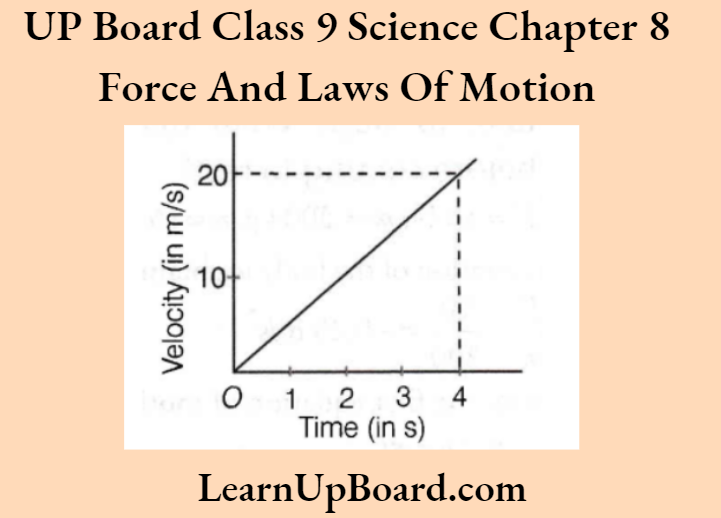
Answer:
The velocity-time graph shows that the velocity of the ball at =0 is zero.
So, the initial velocity of the ball, u = 0.
Velocity of the ball at t = 4 s is 20 m/s
i.e. final velocity, v =20 m/s; Time, t = 4 s
Acceleration of the ball, a =\(\frac{v-u}{t}=\frac{20 \mathrm{~m} / \mathrm{s}-0}{4 \mathrm{~s}}\)
=5 \(\mathrm{~m} / \mathrm{s}^2\)
Also, the mass of the ball,
m=100 \(\mathrm{~g}=\frac{100}{1000} \mathrm{~kg}=\frac{1}{10} \mathrm{~kg}\)
Force acting on the ball, F=m a=\(\frac{1}{10} \mathrm{~kg} \times 5 \mathrm{~m} / \mathrm{s}^2\)
=0.5 \(\mathrm{~kg}-\mathrm{m} / \mathrm{s}^2=0.5 \mathrm{~N}[1 \mathrm{~kg}-\mathrm{m} / \mathrm{s}^2=1 \mathrm{~N}]\)
Question 37. The speed-time graph of a car is given. The car weighs 1000 kg.
- What is the distance traveled by the car in the first 2s?
- What is the braking force applied at the end of 5 s to bring the car to stop within one second?
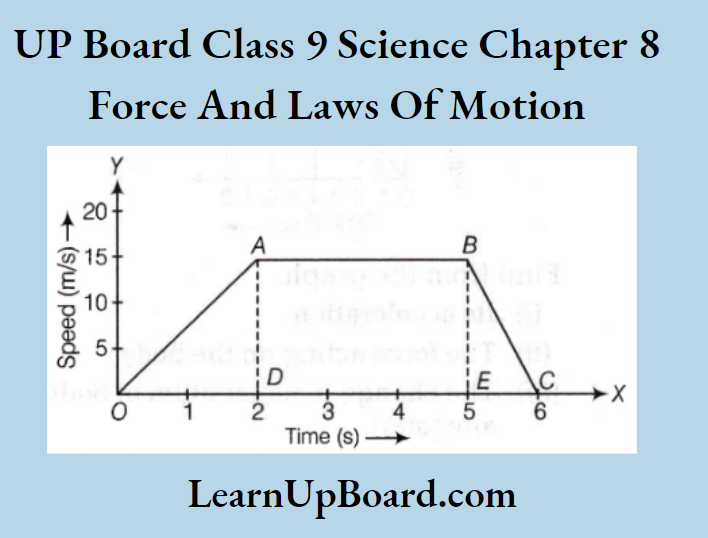
Answer:
(1) Distance traveled by the car in first 2 s= Area of \(\triangle\) O A D=\(\frac{1}{2} \times 2 \times 15=15 \mathrm{~m}\)
(2) Braking force, F=m \(\times\) a
Given, mass of the car, m=1000 kg, initial velocity, u=15 m/s,
final velocity, v=0, time, t = 1s
On applying, a=\(\frac{v-u}{t} \Rightarrow a=\frac{0-15}{1}=-15 \mathrm{~m} / \mathrm{s}^2\)
F = ma =1000 \(\times(-15)\)=-15000 N
Question 38. A constant force of friction of 50 N is acting on a body of mass 200 kg moving initially with a speed of 15 m/s. How long does the body take to stop? What distance will it cover before coming to rest?
Answer:
Given, F = 50 N, m = 200 kg, u= 15 m/s
The acceleration of the body is obtained from F = ma
or a=\(\frac{F}{m}=\frac{50}{200}=-0.25 \mathrm{~m} / \mathrm{s}^2\)
Now, from the first equation of motion
v=u+a t
t=\(\left(\frac{v-u}{a}\right)=\left(\frac{0-15}{-0.25}\right)=60 \mathrm{~s}\)
Also, the distance traveled is obtained from
s =u t+\(\frac{1}{2} a t^2\)
=50 \(\times 60+1 / 2 \times(-0.25) \times(60)^2=450 \mathrm{~m}\)
Question 39. Look at the diagram below and answer the following questions:
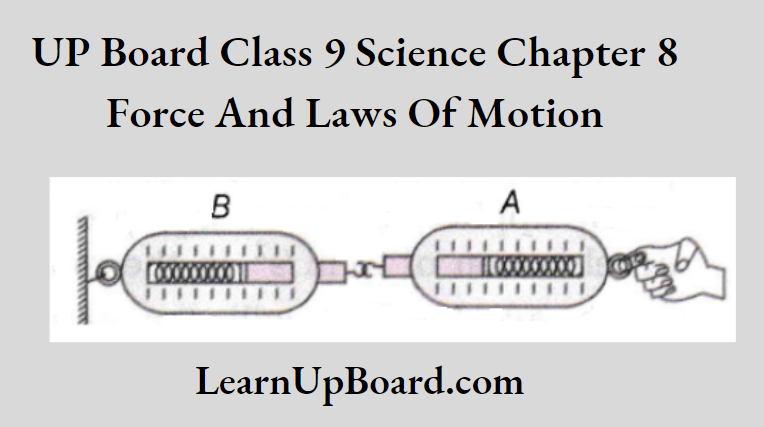
- When a force is applied through the free end of the spring balance A, then the reading on the spring balance A is 15 g-wt. What will be the measure of the reading shown by spring balance B?
- Write reasons for your answer.
- Name the force that balance A exerts on balance B and the force of balance B on balance A.
Answer:
- 15 g-wt.
- From Newton’s third law, the force exerted by B on A and the force exerted by A on B is equal.
- Force of reaction balance A exerts on balance B and force of action balance B exerts on balance A.
Question 40. An iron sphere of mass 1 kg is dropped from a height of 10 m. If the acceleration of the sphere is 9.8 m/s², then calculate the momentum transferred to the ground by the ball.
Answer:
Given
An iron sphere of mass 1 kg is dropped from a height of 10 m. If the acceleration of the sphere is 9.8 m/s²,
Here, initial velocity of sphere, u = 0 Distance travelled, s = 10 m
Acceleration of sphere, a = 9.8 m/s²
Final velocity, v =?
The final velocity of the sphere when it just reaches the ground can be calculated using the,
v² – u² = 2 as
⇒ v² -0 = 2 x 9.8 x 10 =196 m/s
v = √196 m/s = 14 m/s
Momentum of the sphere just before it touches the ground = mv
= 1 kg x 14 m/s =14 kg-m/s
On reaching the ground, the iron sphere comes to rest, so its final momentum is equal to zero.
According to the law of conservation of momentum, momentum transferred to the ground = momentum of the sphere just before it comes to rest = 14 kg-m/s
Class 9 Science Chapter 8 Long Answer Type Questions
Question 1. What is momentum? Write its SI unit. Interpret force in terms of momentum. Represent the following graphically:
- Momentum versus velocity when mass is fixed.
- Momentum versus mass when velocity is constant.
Answer:
Momentum:
Momentum The quantity of motion possessed by a moving body is known as the momentum of the body.
It is the product of the mass and velocity of the body. Momentum, p = mu. Its SI unit is kg-m/s
Force applied on an object of mass m moving with acceleration a.
F=m a=m \(\frac{\Delta v}{\Delta t}\)
[acceleration = rate of change of velocity =\(\frac{\Delta v}{\Delta t}]\)}
=\(\frac{\Delta p}{\Delta t}\)
Force applied on an object is equal to the rate of change of momentum of the object.
(1) Momentum versus velocity graph when mass is fixed, p=m v. If m is fixed, then p \(\propto v\)
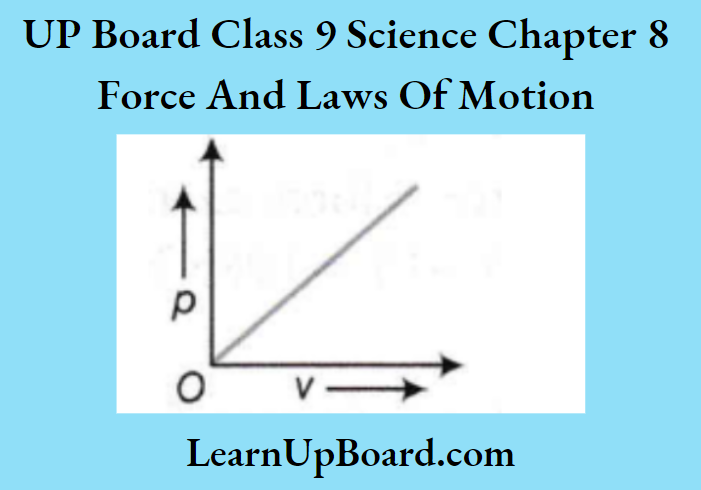
The momentum versus velocity graph will be a straight line passing through the origin (if v=0, then p=0 ).
(2) Momentum versus mass graph when velocity is constant, p — mv.
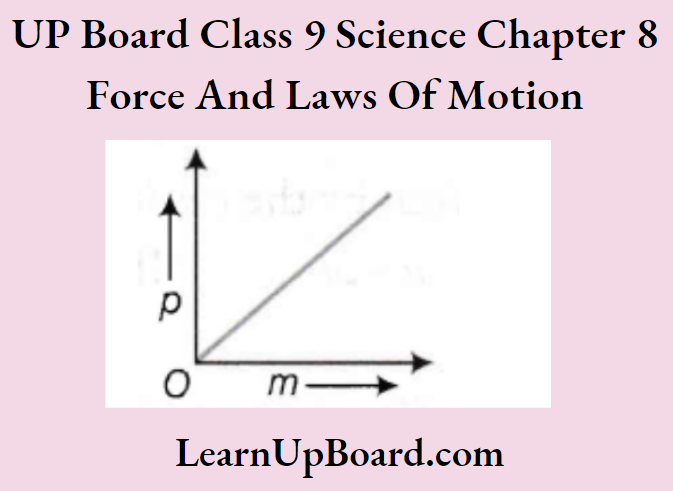
If velocity is constant, then p m.
So, the momentum versus mass graph will be a straight line passing through the origin (if m = 0, then p = 0).
Question 2. (1) When a carpet is beaten with a stick dust comes out of it. Explain.
(2) Calculate the force required to impart a car with a velocity of 30 m/s in 10 s starting from rest. The mass of the car is 15000 kg.
Answer:
(1) When we beat the carpet with a strick, then it comes into motion. However, the dust particles continue to be at rest due to inertia and get detached from the carpet.
(2) Given, initial velocity, u = 30 m/s
Time, t = 10 s, final velocity, v = 0
Mass, m = 15000 kg
From first equation of motion, a=\(\frac{v-u}{t}=\frac{-30}{10}=-3 \mathrm{~m} / \mathrm{s}^2\)
So, retarding force required = ma
= 15000 x (-3) = – 45000 N
Thus, the force required by the car is 45000 N.
Question 3. An object of mass 5 kg is accelerated uniformly from a velocity of 4 m/s to 8 m/s in 8 s. Calculate the initial and final momentum of the object. Also, find the magnitude of the force exerted on the object.
Answer:
Given,
An object of mass 5 kg is accelerated uniformly from a velocity of 4 m/s to 8 m/s in 8 s.
mass, m=5 kg, initial velocity, u=4 m/s
Final velocity, v=8 m/s, time, t=8 s
Initial momentum, \(p_1\)=m u=5 \(\times\) 4=20 kg- m/s and final momentum, \(p_2=m v=5 \times 8\)
=40 kg – m/s
Now, force =\(\frac{\Delta p}{t}=\frac{p_2-p_1}{t}=\frac{40-20}{8}=\frac{20}{8} N\) = 2.5 N
Question 4. Using the second law of motion, derive the relation between force and acceleration. A bullet of 10 g strikes a sandbag at a speed of \(10^3 \mathrm{~m} / \mathrm{s}\) and gets embedded after traveling 5 cm. Calculate
- The resistive force exerted by sand on the bullet.
- The time is taken by a bullet to come to rest.
Answer:
Given, m=10 g=0.01kg, u=\(10^3 \mathrm{~m} / \mathrm{s}\), v=0,
s=5 cm=0.05 m, t=?, a=?, F=?
(1) From the third equation of motion,
a=\(\frac{v^2-u^2}{2 s}=\frac{0-\left(10^3\right)^2}{2 \times 0.05}=-10^7 \mathrm{~m} / \mathrm{s}^2\)
The force applied by the bullet,
F=m a=0.01 \(\times\left(-10^7\right)=-10^5 \mathrm{~N}\)
[negative sign shows that force is against the direction of motion]
The resistive force exerted by the sand on the bullet is \(10^5\) N.
(2) Time taken by a bullet to come to rest,
t=\(\frac{v-u}{a}=\frac{0-10^3}{-10^7}=10^{-4} \mathrm{~s}\)
Question 5. Derive the unit of force using the second law of motion. A force of 5 N produces an acceleration of 8 \(m/s^2\) on a mass \(m_1\) and an acceleration of 24 \(\mathrm{~m} / \mathrm{s}^2\) on a mass \(m_2\). What acceleration would the same provide, if both the masses are tied together?
Answer:
⇒ \(F_1=5 \mathrm{~N}, a_1=8 \mathrm{~m} / \mathrm{s}^2, m_1\)= ?
⇒ \(F_2=5 \mathrm{~N}, a_2=24 \mathrm{~m} / \mathrm{s}^2, m_2\)=?
⇒ From , F=m a, 5 = \(m_1 \times 8\)
⇒ \(m_1=\frac{5}{8} \mathrm{~kg}\)
Similarly, \(5=m_2 \times 24\)
⇒ \(m_2=\frac{5}{24} \mathrm{~kg}\)
⇒ \(m_1+m_2=\frac{5}{8}+\frac{5}{24}\)
= \(\frac{15+5}{24}=\frac{20}{24}=\frac{5}{6}\)
Given that acceleration produced by the same force provided, if both the masses are tied together is
a =\(\frac{F}{\left(m_1+m_2\right)}\)
= \(\frac{5}{5 / 6}=6 \mathrm{~m} / \mathrm{s}^2\)
Question 6. If the engine of a car provides an acceleration of 2 m/s² to start it from rest, then assuming the mass to be roughly 1000 kg. Calculate
- force provided by the engine.
- velocity after 10 s.
- time after which the car comes to rest, if the engine is turned off after 15 s. (take, frictional force =15 N)
Answer:
Given, initial velocity, u=0 m/s
Acceleration, a=2 \(m / s^2\),
Mass, m=1000 kg
(1) From Newton’s second law of motion, force = mass \(\times\) acceleration
F=m a=1000 \(\times\) 2=2000 N
(2) Velocity after 10 s,
from the first equation of motion,
v=u+a t
v=0+2 \(\times\) 10=20 m/s
(3) Final velocity of the car when the engine is on after 15 s.
v=0+2 \(\times\) 15=30 m/s [t=15 s]
So, p=m v
=1000 \(\times\) 20=20000 \(\mathrm{~kg}-\mathrm{m} / \mathrm{s}\)
After 15 s, net force = force exerted by engine + friction force
=2000-15=1985 N [friction force=15 N]
[Here, friction force is subtracted because it opposes the motion]
Acceleration =\(\frac{\text { Net force }}{\text { Mass }} \Rightarrow a=\frac{1985}{1000}\)
a=1.985 \(\mathrm{~m} / \mathrm{s}^2 \approx 2 \mathrm{~m} / \mathrm{s}^2\)
Time taken by the car (comes to rest)
v=u-a t [first equation of motion][final velocity, v=0]}
0=30-2 \(\times\) t
2 t=30 [from Eq. (1)]
t=15 s
